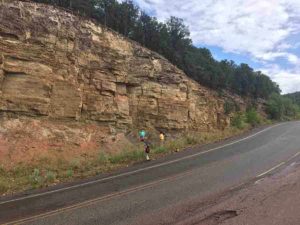
Geologists inspect an outcrop near the sample collection site in New Mexico.
A University of Alaska Fairbanks scientist has discovered a method for detecting and better defining meteorite impact sites that have long lost their tell-tale craters. The discovery could further the study of not only Earth’s geology but also that of other bodies in our solar system.
The key, according to work by associate research professor Gunther Kletetschka at the UAF Geophysical Institute, is in the greatly reduced level of natural remanent magnetization of rock that has been subjected to the intense forces from a meteor as it nears and then strikes the surface.
Rocks unaltered by humanmade or non-Earth forces have 2% to 3% natural remanent magnetization, meaning they consist of that quantity of magnetic mineral grains — usually magnetite or hematite or both. Kletetschka found that samples collected at the Santa Fe Impact Structure in New Mexico contained less than 0.1% magnetism.
Kletetschka determined that plasma created at the moment of impact and a change in the behavior of electrons in the rocks’ atoms are the reasons for the minimal magnetism.
Kletetschka reported his findings in a paper published Wednesday in the journal Scientific Reports.
The Santa Fe Impact Structure was discovered in 2005 and is estimated to be about 1.2 billion years old. The site consists of easily recognized shatter cones, which are rocks with fantail features and radiating fracture lines. Shatter cones are believed to only form when a rock is subjected to a high-pressure, high-velocity shock wave such as from a meteor or nuclear explosion.
Kletetschka’s work will now allow researchers to determine an impact site before shatter cones are discovered and to better define the extent of known impact sites that have lost their craters due to erosion.
“When you have an impact, it’s at a tremendous velocity,” Kletetschka said. “And as soon as there is a contact with that velocity, there is a change of the kinetic energy into heat and vapor and plasma. A lot of people understand that there is heat, maybe some melting and evaporation, but people don’t think about plasma.”
Plasma is a gas in which atoms have been broken into free-floating negative electrons and positive ions.
“We were able to detect in the rocks that a plasma was created during the impact,” he said.
Earth’s magnetic field lines penetrate everything on the planet. Magnetic stability in rocks can be knocked out temporarily by a shock wave, as they are when hitting an object with a hammer, for example. The magnetic stability in rocks returns immediately after the shock wave passes.
At Santa Fe, the meteorite’s impact sent a massive shock wave through the rocks, as expected. Kletetschka found that the shock wave altered the characteristics of atoms in the rocks by modifying the orbits of certain electrons, leading to their loss of magnetism.
The modification of the atoms would allow for a quick remagnetization of the rocks, but Kletetschka also found that the meteorite impact had weakened the magnetic field in the area. There was no way for the rocks to regain their 2% to 3% magnetism even though they had the capability to do so.
That’s because of the presence of plasma in the rocks at the impact surface and below. Presence of the plasma increased the rocks’ electrical conductivity as they converted to vapor and molten rock at the leading edge of the shock wave, temporarily weakening the ambient magnetic field.
“This plasma will shield the magnetic field away, and therefore the rock finds only a very small field, a residue,” Kletetschka said.
Kletetschka is also affiliated with Charles University in Prague, Czech Republic. Charles University students Radana Kavkova and Hakan Ucar assisted in the research.
Reference:
Gunther Kletetschka, Radana Kavkova, Hakan Ucar. Plasma shielding removes prior magnetization record from impacted rocks near Santa Fe, New Mexico. Scientific Reports, 2021; 11 (1) DOI: 10.1038/s41598-021-01451-8
Note: The above post is reprinted from materials provided by University of Alaska Fairbanks.









